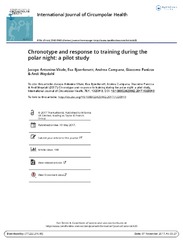Chronotype and response to training during the polar night: a pilot study
Permanent link
https://hdl.handle.net/10037/11723Date
2017-05-19Type
Journal articleTidsskriftartikkel
Peer reviewed
Abstract
Background:
An individual’s chronotype influences his or her physiological rhythms. Some studies have looked at the effect of time of day on the responses to exercise, but studies on the effect of long-term training are lacking.
Objective:
To report the effects of an 8-week training period during the polar night in non- athletes of different chronotypes living at 70°N.
Design:
In all, 10 morning (M), 10 neither (N) and 10 evening (E) types were recruited, and their aerobic capacity (VO 2max ), strength, flexibility and balance before and after the training period were tested. Results: 3 E-types, 5 N-types and 6 M-types completed the protocol. An increase in VO 2max and strength was observed for the whole group. The best negative correlation (r= – 0.5287) was found between the Morningness – Eveningness Questionnaire (MEQ) score and the increase in VO2max, and the best positive correlation (r=0.4395) was found between MEQ and the increase in strength. Changes in balance and flexibility did not show any clear trends.
Conclusion:
In an environment with no outdoor daylight, it seems that the response to 8 weeks of aerobic training is larger in the E- than in the M-types, although the M-types showed a larger improvement in strength.
An individual’s chronotype influences his or her physiological rhythms. Some studies have looked at the effect of time of day on the responses to exercise, but studies on the effect of long-term training are lacking.
Objective:
To report the effects of an 8-week training period during the polar night in non- athletes of different chronotypes living at 70°N.
Design:
In all, 10 morning (M), 10 neither (N) and 10 evening (E) types were recruited, and their aerobic capacity (VO 2max ), strength, flexibility and balance before and after the training period were tested. Results: 3 E-types, 5 N-types and 6 M-types completed the protocol. An increase in VO 2max and strength was observed for the whole group. The best negative correlation (r= – 0.5287) was found between the Morningness – Eveningness Questionnaire (MEQ) score and the increase in VO2max, and the best positive correlation (r=0.4395) was found between MEQ and the increase in strength. Changes in balance and flexibility did not show any clear trends.
Conclusion:
In an environment with no outdoor daylight, it seems that the response to 8 weeks of aerobic training is larger in the E- than in the M-types, although the M-types showed a larger improvement in strength.


 English
English norsk
norsk